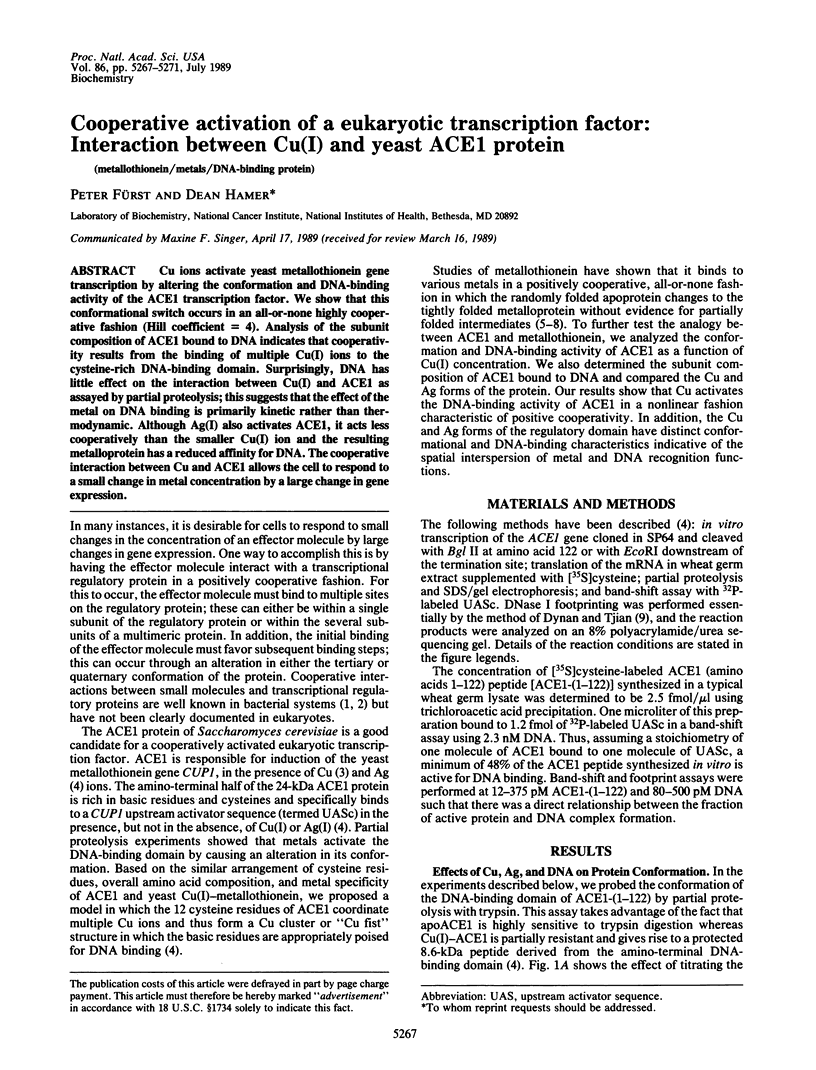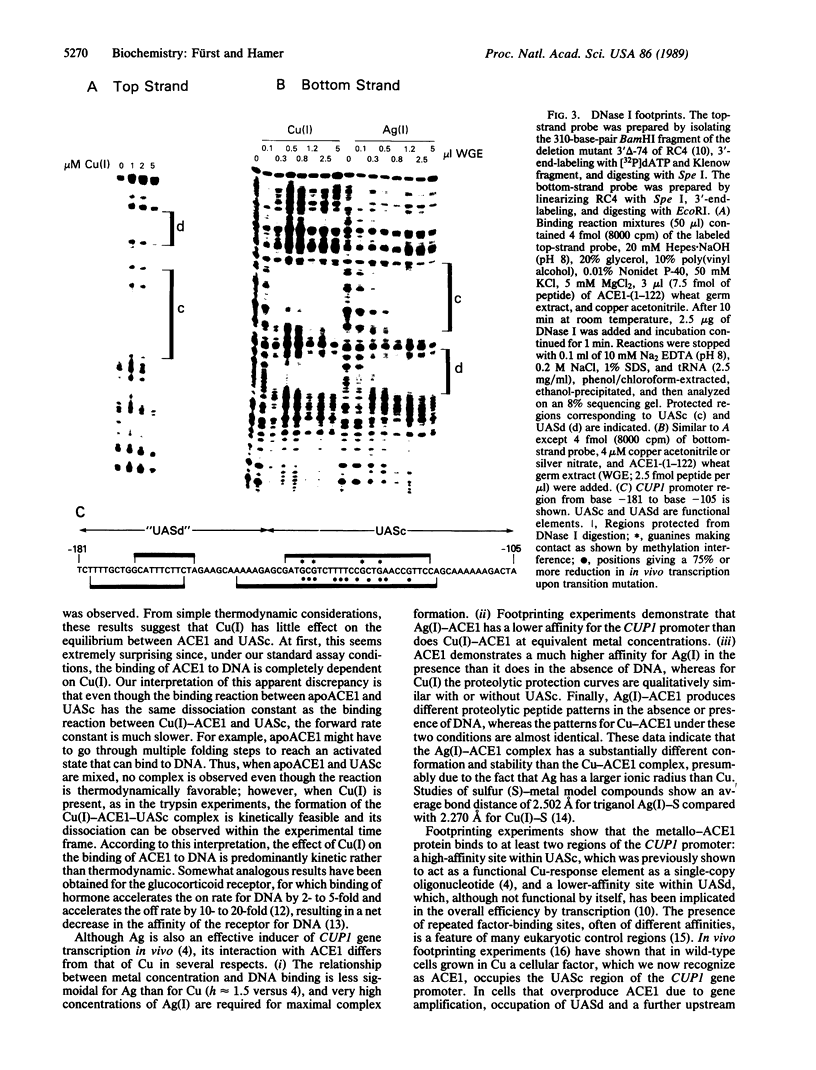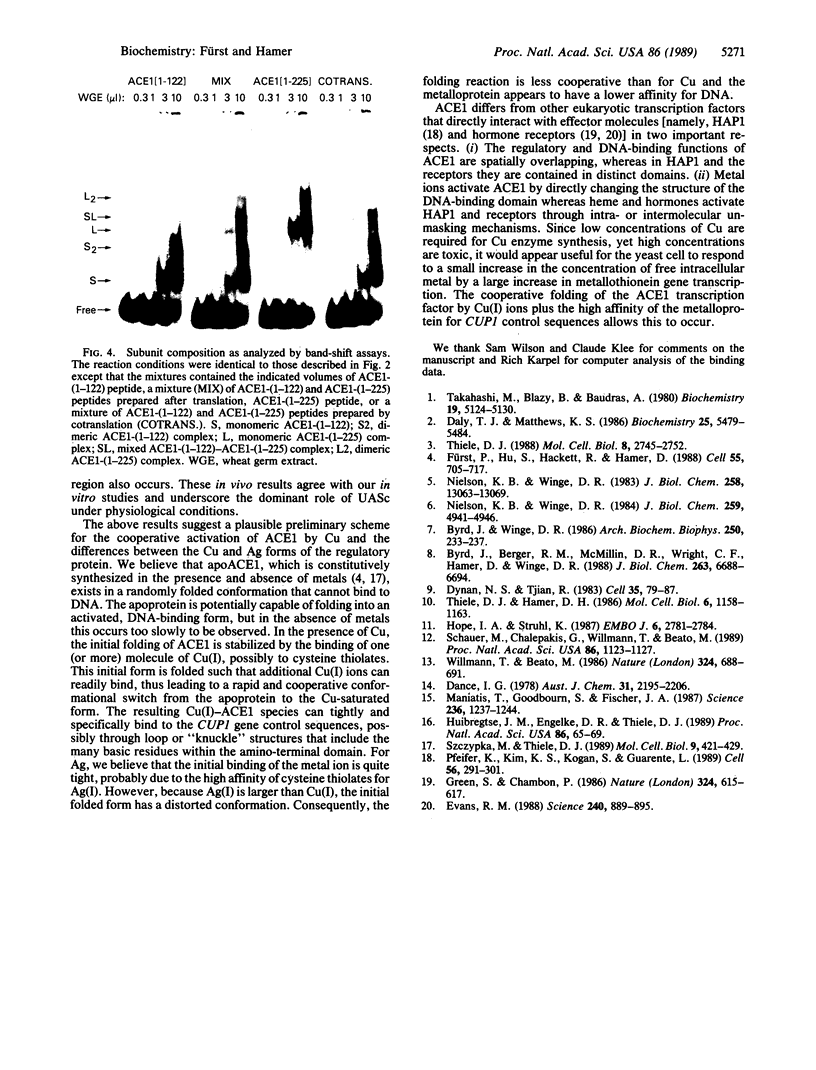Abstract
Cu ions activate yeast metallothionein gene transcription by altering the conformation and DNA-binding activity of the ACE1 transcription factor. We show that this conformational switch occurs in an all-or-none highly cooperative fashion (Hill coefficient = 4). Analysis of the subunit composition of ACE1 bound to DNA indicates that cooperativity results from the binding of multiple Cu(I) ions to the cysteine-rich DNA-binding domain. Surprisingly, DNA has little effect on the interaction between Cu(I) and ACE1 as assayed by partial proteolysis; this suggests that the effect of the metal on DNA binding is primarily kinetic rather than thermodynamic. Although Ag(I) also activates ACE1, it acts less cooperatively than the smaller Cu(I) ion and the resulting metalloprotein has a reduced affinity for DNA. The cooperative interaction between Cu and ACE1 allows the cell to respond to a small change in metal concentration by a large change in gene expression.
Full text
PDF




Images in this article
Selected References
These references are in PubMed. This may not be the complete list of references from this article.
- Byrd J., Berger R. M., McMillin D. R., Wright C. F., Hamer D., Winge D. R. Characterization of the copper-thiolate cluster in yeast metallothionein and two truncated mutants. J Biol Chem. 1988 May 15;263(14):6688–6694. [PubMed] [Google Scholar]
- Byrd J., Winge D. R. Cooperative cluster formation in metallothionein. Arch Biochem Biophys. 1986 Oct;250(1):233–237. doi: 10.1016/0003-9861(86)90721-6. [DOI] [PubMed] [Google Scholar]
- Daly T. J., Matthews K. S. Allosteric regulation of inducer and operator binding to the lactose repressor. Biochemistry. 1986 Sep 23;25(19):5479–5484. doi: 10.1021/bi00367a020. [DOI] [PubMed] [Google Scholar]
- Dynan W. S., Tjian R. The promoter-specific transcription factor Sp1 binds to upstream sequences in the SV40 early promoter. Cell. 1983 Nov;35(1):79–87. doi: 10.1016/0092-8674(83)90210-6. [DOI] [PubMed] [Google Scholar]
- Evans R. M. The steroid and thyroid hormone receptor superfamily. Science. 1988 May 13;240(4854):889–895. doi: 10.1126/science.3283939. [DOI] [PMC free article] [PubMed] [Google Scholar]
- Fürst P., Hu S., Hackett R., Hamer D. Copper activates metallothionein gene transcription by altering the conformation of a specific DNA binding protein. Cell. 1988 Nov 18;55(4):705–717. doi: 10.1016/0092-8674(88)90229-2. [DOI] [PubMed] [Google Scholar]
- Green S., Chambon P. A superfamily of potentially oncogenic hormone receptors. Nature. 1986 Dec 18;324(6098):615–617. doi: 10.1038/324615a0. [DOI] [PubMed] [Google Scholar]
- Hope I. A., Struhl K. GCN4, a eukaryotic transcriptional activator protein, binds as a dimer to target DNA. EMBO J. 1987 Sep;6(9):2781–2784. doi: 10.1002/j.1460-2075.1987.tb02573.x. [DOI] [PMC free article] [PubMed] [Google Scholar]
- Huibregtse J. M., Engelke D. R., Thiele D. J. Copper-induced binding of cellular factors to yeast metallothionein upstream activation sequences. Proc Natl Acad Sci U S A. 1989 Jan;86(1):65–69. doi: 10.1073/pnas.86.1.65. [DOI] [PMC free article] [PubMed] [Google Scholar]
- Maniatis T., Goodbourn S., Fischer J. A. Regulation of inducible and tissue-specific gene expression. Science. 1987 Jun 5;236(4806):1237–1245. doi: 10.1126/science.3296191. [DOI] [PubMed] [Google Scholar]
- Nielson K. B., Winge D. R. Order of metal binding in metallothionein. J Biol Chem. 1983 Nov 10;258(21):13063–13069. [PubMed] [Google Scholar]
- Nielson K. B., Winge D. R. Preferential binding of copper to the beta domain of metallothionein. J Biol Chem. 1984 Apr 25;259(8):4941–4946. [PubMed] [Google Scholar]
- Pfeifer K., Kim K. S., Kogan S., Guarente L. Functional dissection and sequence of yeast HAP1 activator. Cell. 1989 Jan 27;56(2):291–301. doi: 10.1016/0092-8674(89)90903-3. [DOI] [PubMed] [Google Scholar]
- Schauer M., Chalepakis G., Willmann T., Beato M. Binding of hormone accelerates the kinetics of glucocorticoid and progesterone receptor binding to DNA. Proc Natl Acad Sci U S A. 1989 Feb;86(4):1123–1127. doi: 10.1073/pnas.86.4.1123. [DOI] [PMC free article] [PubMed] [Google Scholar]
- Szczypka M. S., Thiele D. J. A cysteine-rich nuclear protein activates yeast metallothionein gene transcription. Mol Cell Biol. 1989 Feb;9(2):421–429. doi: 10.1128/mcb.9.2.421. [DOI] [PMC free article] [PubMed] [Google Scholar]
- Takahashi M., Blazy B., Baudras A. An equilibrium study of the cooperative binding of adenosine cyclic 3',5'-monophosphate and guanosine cyclic 3',5'-monophosphate to the adenosine cyclic 3',5'-monophosphate receptor protein from Escherichia coli. Biochemistry. 1980 Oct 28;19(22):5124–5130. doi: 10.1021/bi00563a029. [DOI] [PubMed] [Google Scholar]
- Thiele D. J. ACE1 regulates expression of the Saccharomyces cerevisiae metallothionein gene. Mol Cell Biol. 1988 Jul;8(7):2745–2752. doi: 10.1128/mcb.8.7.2745. [DOI] [PMC free article] [PubMed] [Google Scholar]
- Thiele D. J., Hamer D. H. Tandemly duplicated upstream control sequences mediate copper-induced transcription of the Saccharomyces cerevisiae copper-metallothionein gene. Mol Cell Biol. 1986 Apr;6(4):1158–1163. doi: 10.1128/mcb.6.4.1158. [DOI] [PMC free article] [PubMed] [Google Scholar]
- Willmann T., Beato M. Steroid-free glucocorticoid receptor binds specifically to mouse mammary tumour virus DNA. Nature. 1986 Dec 18;324(6098):688–691. doi: 10.1038/324688a0. [DOI] [PubMed] [Google Scholar]










